
Pilatus - self-guided Golden Round Trip from Lucerne including boat cruise
Validity: All day
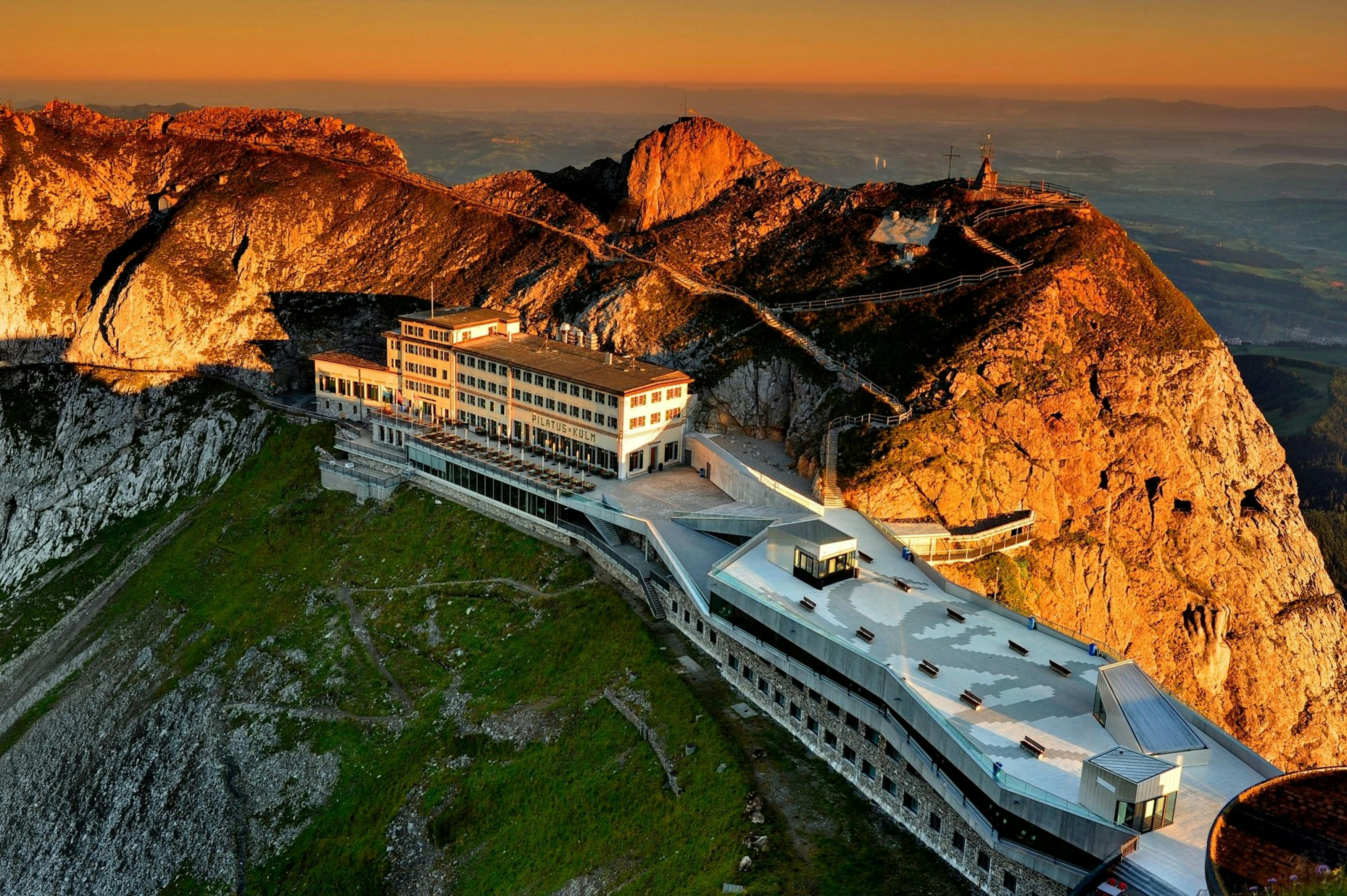
12 Activities
Filter
Better than 4.5 stars
Better than 4 stars
Better than 3.5 stars
Better than 3 stars
No Rating

Validity: All day
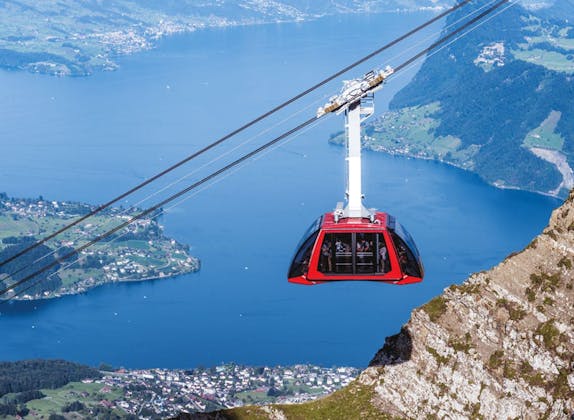
Validity: All day
Why book with Swiss Activities?

Validity: All day
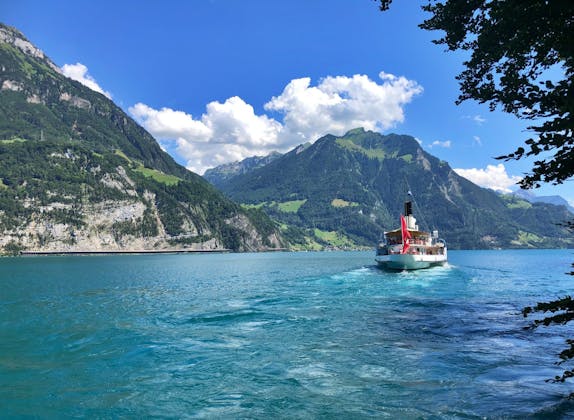
Validity: All day
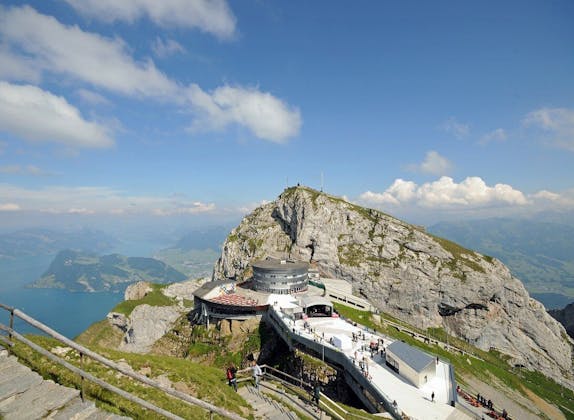
Duration: 5 hours

Duration: 3 hours

Duration: 9 hours

Duration: 11:30 hours

Validity: All day
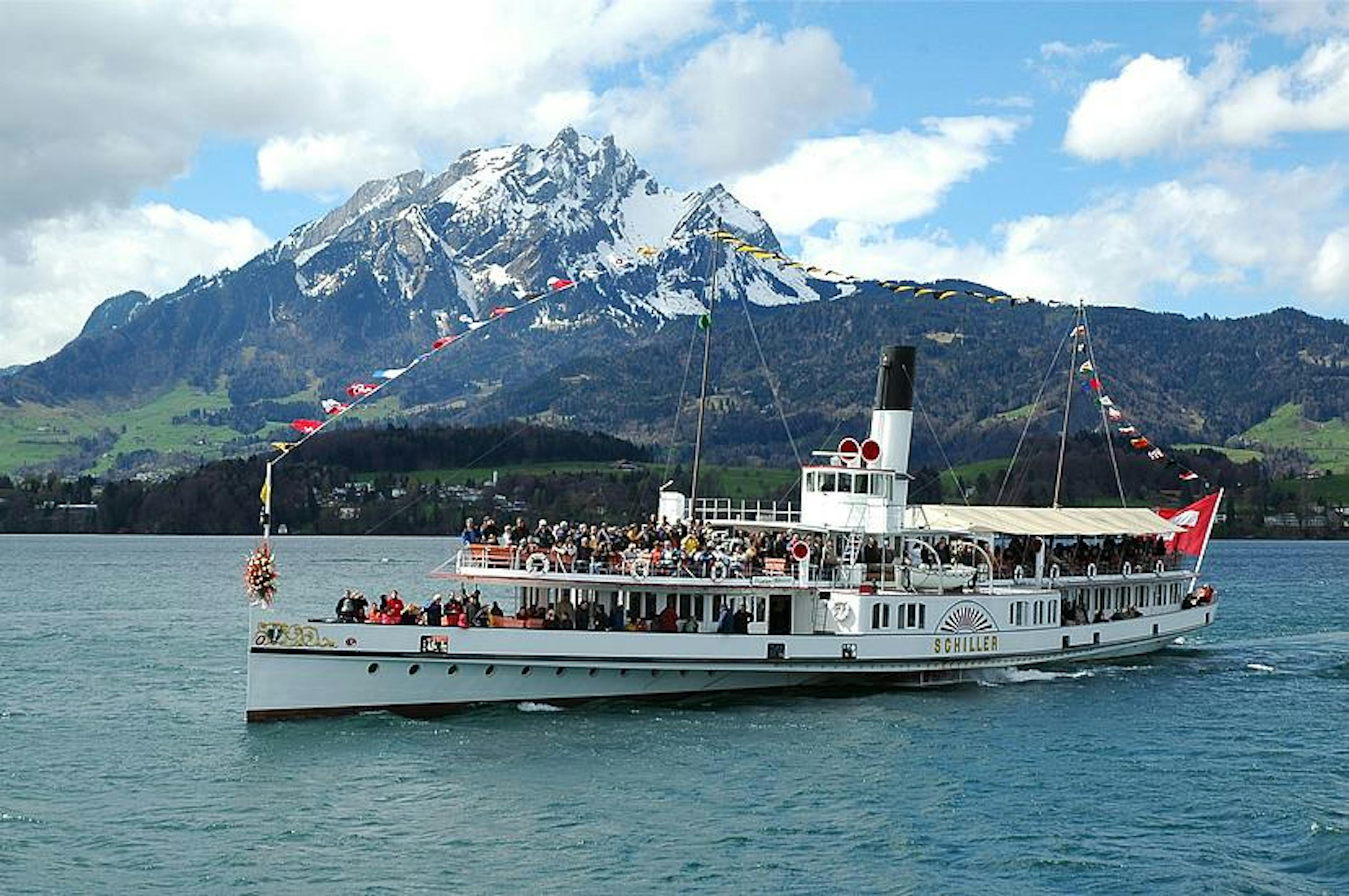
Ticket
High demandbooked 15,984 times
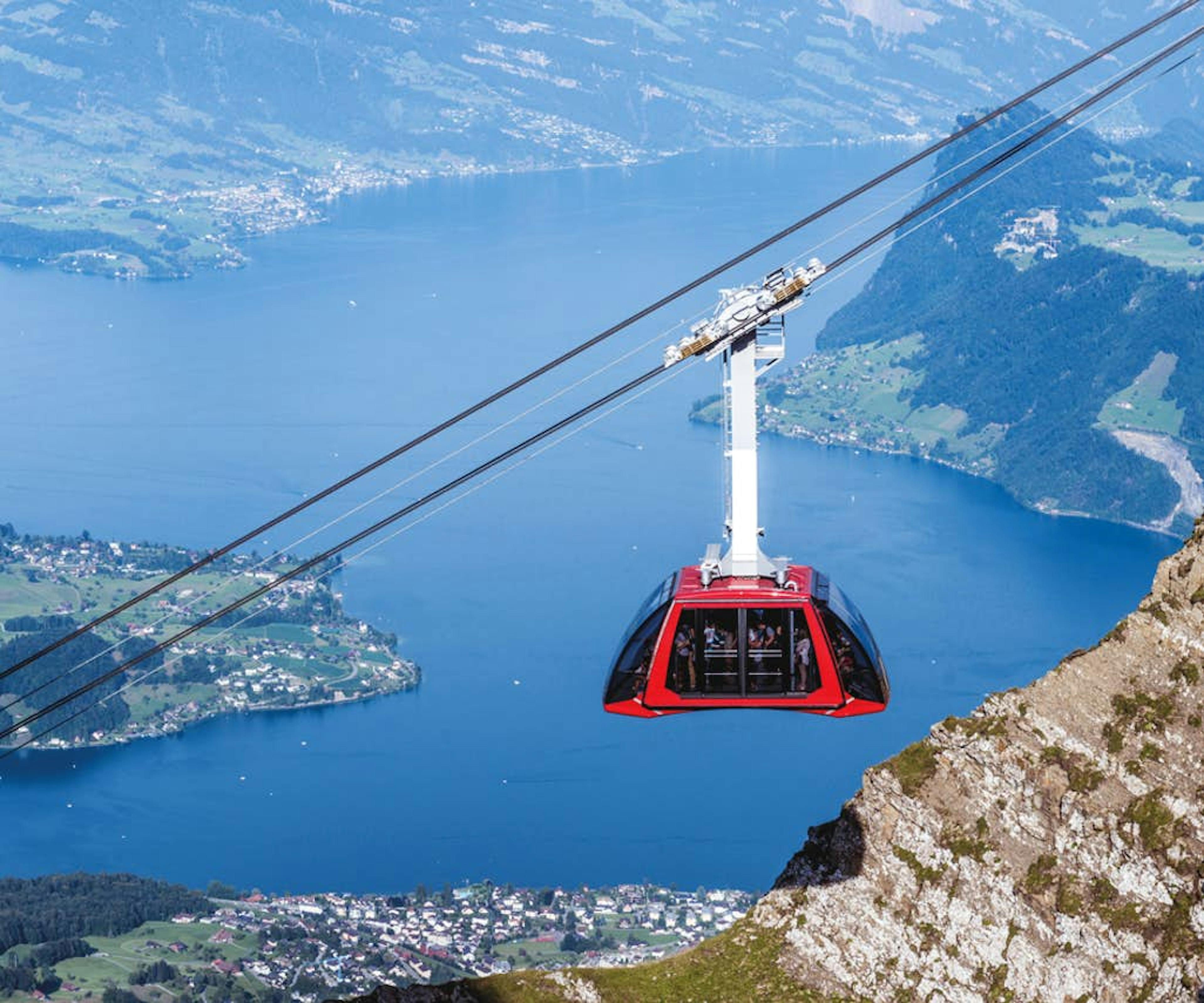
Ticket
High demandbooked 4,591 times
Why book with Swiss Activities?
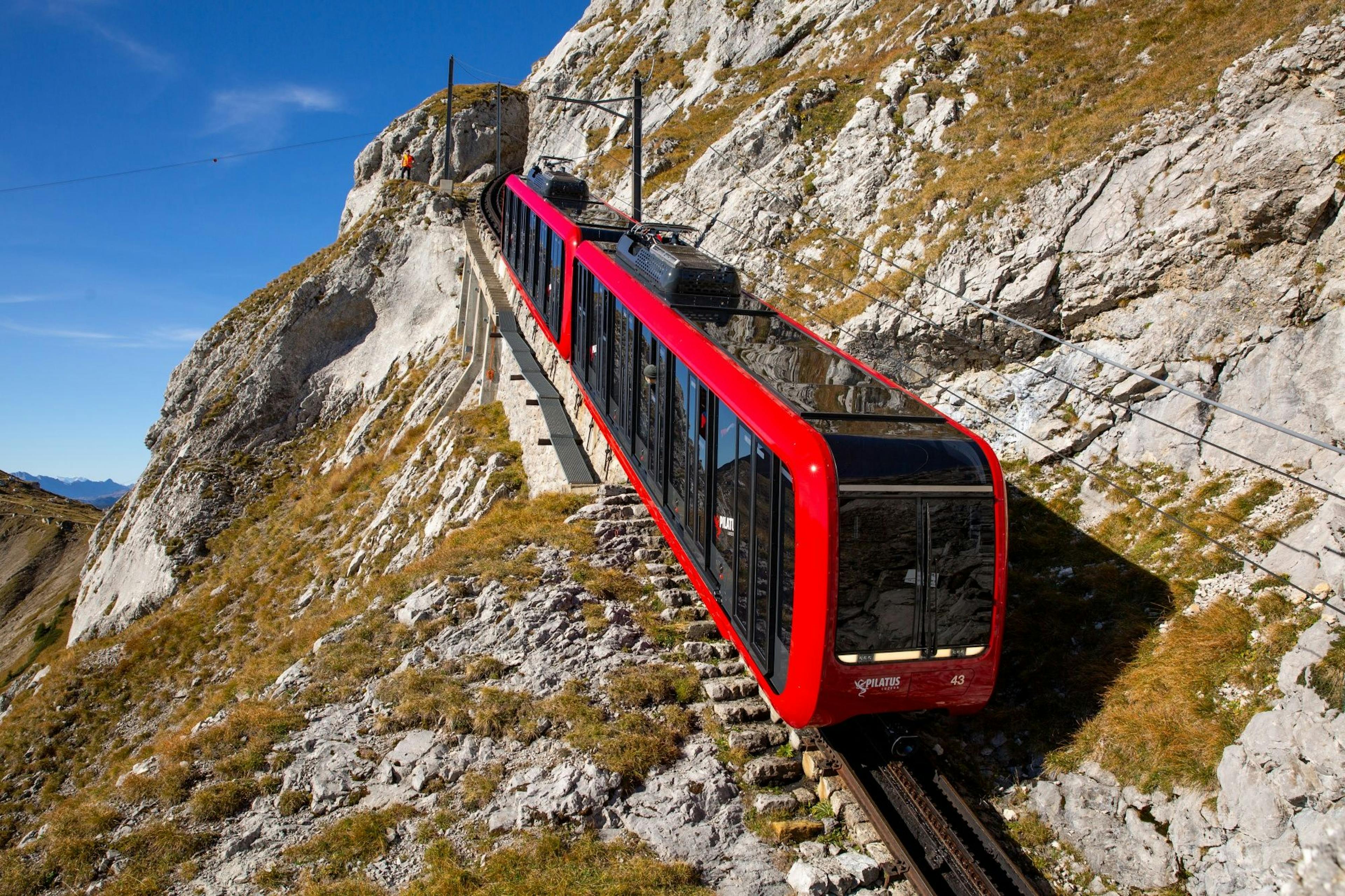
Ticket
High demandbooked 4,447 times

Passports
High demandbooked 71 times

Tour
Duration: 5 hours
booked 23 times

Adventure
Duration: 3 hours
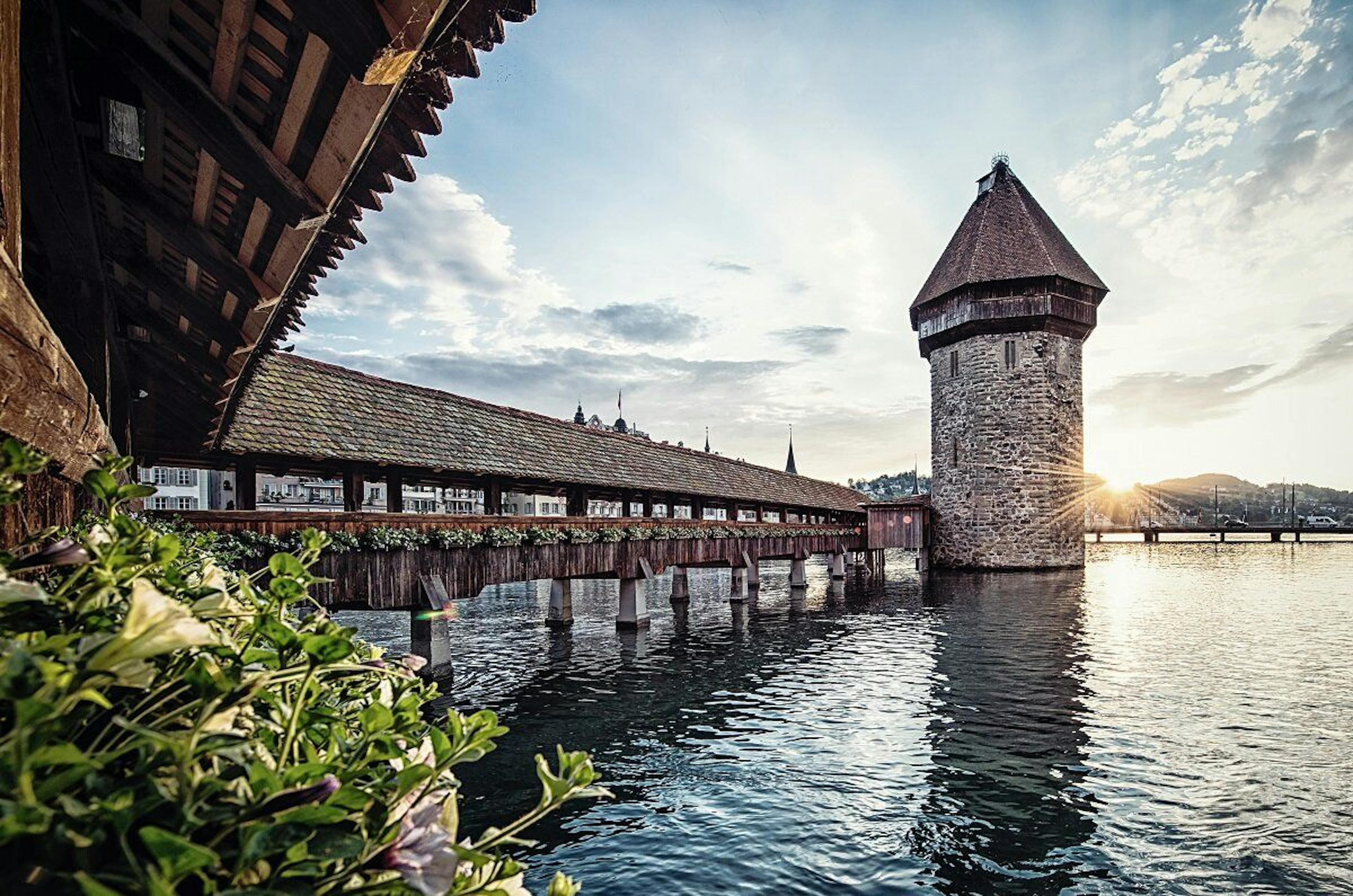
Tour
Duration: 9 hours

Tour
Duration: 11:30 hours

Adventure
Sometimes the view goes over the Jura to the Black Forest. Other times, only a sea of clouds or fog is visible, which perfectly matches the myth of the mountain. Many old legends revolve around the Pilatus massif. With it, people sought an explanation for the frequent, sudden and violent storms on the mountain
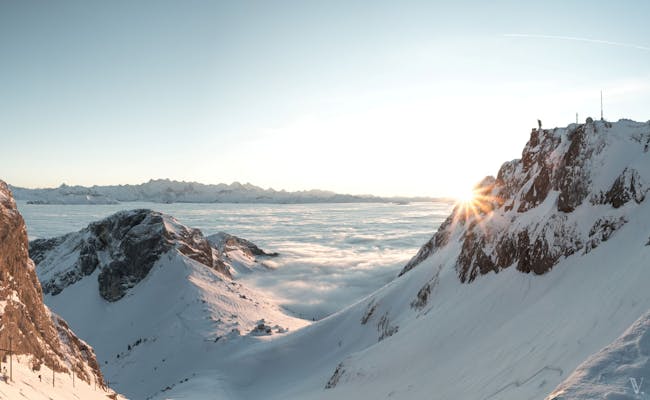 Pilatus Sunset Winter Mood (Photo: (c) PILATUS-BAHNEN AG)
Pilatus Sunset Winter Mood (Photo: (c) PILATUS-BAHNEN AG)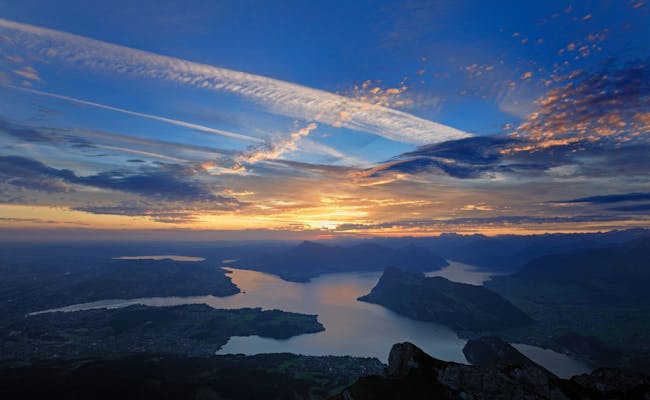 Pilatus Sunrise from Esel (Photo: (c) PILATUS-BAHNEN AG)
Pilatus Sunrise from Esel (Photo: (c) PILATUS-BAHNEN AG)On Mount Pilatus there are several hilltops and vantage points that allow a wide view over the lake landscape. Dragon World brings the legends of the dragon to life for families
The following sights are available on and around Mount Pilatus:
Mount Pilatus is not a mountain with a single peak. Rather, it is a mountain massif. Several vantage points can be found at Pilatus Kulm. Some of them offer a 360-degree view
The Tomlishorn is the highest mountain peak of the Pilatus massif. It is located on the outer western side of Mount Pilatus and reaches an altitude of 2,129 meters above sea level. In a hike along the flower path the viewpoint is easily accessible. The flower path goes from the Kulm to the Tomlishorn. The flowers growing here are wild. Information boards along the path provide information about the Latin names, the plant species and their flowering time. All alpine plants in the Pilatus region are protected, and not only on the flower trail. The trail is three kilometers long and climbs about 240 meters in altitude along the way. The easy trail can be walked in one to one and a half hours. It runs mostly on the south side of the main ridge. On the outer side it is secured throughout and asphalted until the last section of the trail at the Tomishorn. Steeper rock sections have stairs. Rockflowers, bellflowers, silverroot or liverwort and many other flowers can be seen. The trail is open from June - October.
The mountain peak Oberhaupt shoots to the east. It is situated 2,106 meters above sea level and is also considered a beautiful viewpoint. It can be reached in a few minutes from Hotel Pilatus Kulm. It is the third highest Pilatus peak.
The Esel is the second highest peak of the Pilatus massif and reaches 2,118 meters above sea level. It is located directly at the Hotel Bellevue in the eastern part of the Pilatus massif. The summit offers a panoramic view of Lake Lucerne and the mountains.
The Drachenweg is an adventure trail through the mountain. It starts at Pilatus Kulm. The paths are carved into the mountain and offer repeated views through holes in the rock. The hike through the world of legends on Mount Pilatus can only be walked on some days in winter. Legends about dragons were told around Mount Pilatus for a long time, and there was even talk of a lindworm. A young lad is even said to have fallen into a cave in the middle of two dragons, but they did him no harm. In spring, one of the dragons crawled out of the cave and flew away. The other dragon held his tail in the cave from the outside so that he could pull himself out.
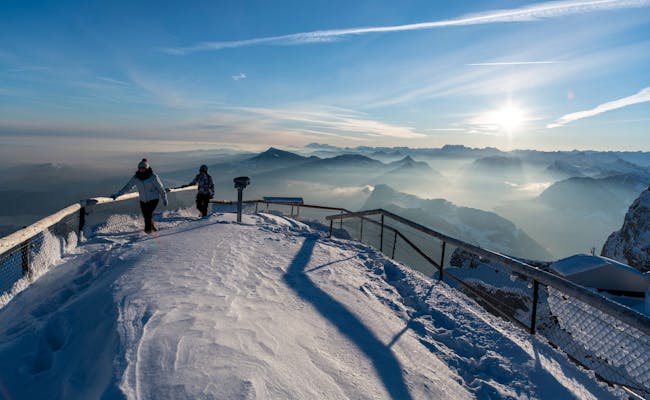 Pilatus Summit (Photo (c) PILATUS-BAHNEN AG)
Pilatus Summit (Photo (c) PILATUS-BAHNEN AG)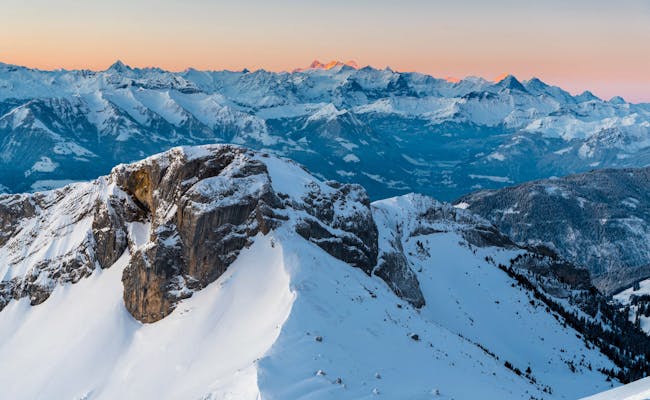 Pilatus Orange Morning Mood View of Matthorn (Photo (c) PILATUS-BAHNEN AG)
Pilatus Orange Morning Mood View of Matthorn (Photo (c) PILATUS-BAHNEN AG)In the past, Mount Pilatus was not appreciated by the people of Lucerne as a local mountain. It was even forbidden under penalty of law to climb it. Terrible storms were associated with the mountain massif, which, for example, would only be triggered by stones falling into Lake Pilatus. According to legend, the body of Pontius Pilate lies in this lake.
Lake Pilatus is located at an altitude of 1548 meters on the Pilatus massif. Although the name Pilate rather comes from "mons pileatus" (mountain with rock struts), it was associated with Pontius Pilate in the Middle Ages. The legend said that the Roman governor was sunk in Lake Pilate. As soon as he was disturbed in the lake, terrible storms would arise. Until the 16th century, even entering the mountain was forbidden under penalty by the Lucerne city council. In the 14th century, six clergymen were imprisoned for trying to climb the mountain. It was not until the end of the 16th century that the dean and the town clerk went to the lake with the magistrate and some citizens to disprove the legend. They churned it up, threw stones into it and waded through the water. No storm followed. However, "to be on the safe side", the lake was subsequently drained. Today it is a watery moor.
The Drachenstein got its name after a farmer swore that he had seen a dragon land on a rock on Mount Pilatus. In the summer of 1421, according to the legend, a huge dragon flew to Mount Pilatus and crashed down so close to a farmer that he fainted from fright. When he woke up again, the dragon was gone, but there was a dragon stone lying next to coagulated blood. The healing effect of this stone was even officially confirmed in 1509. Another story says that the dragon dropped this stone when approaching Mount Pilate. The dragon stone passed from owner to owner and was purchased by the city of Lucerne in 1921. Today it can be seen in the Museum of Nature in Lucerne. A computer tomography carried out in 2006 showed that the stone is not a meteorite, as was sometimes assumed. It probably consists of clay. Its origin is still unclear.
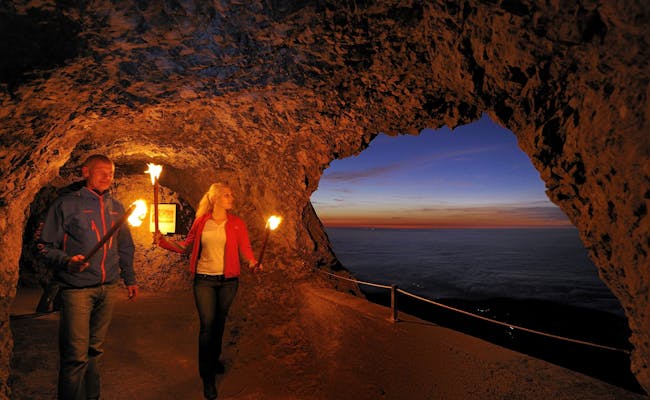 Pilatus Dragon Way (Photo (c) PILATUS-BAHNEN AG)
Pilatus Dragon Way (Photo (c) PILATUS-BAHNEN AG)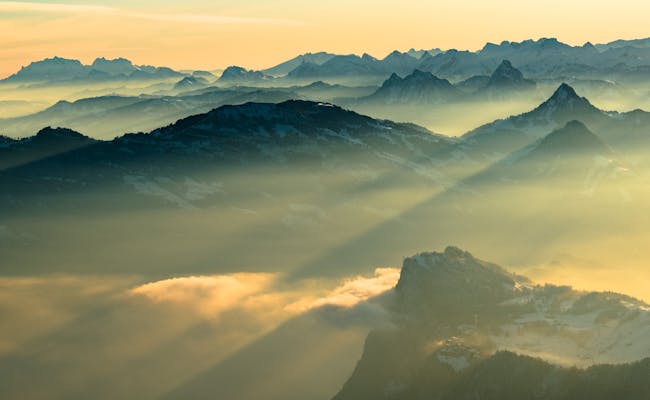 Pilatus Dawn (Photo (c) PILATUS-BAHNEN AG)
Pilatus Dawn (Photo (c) PILATUS-BAHNEN AG)The Mondmilchloch is a karst cave in the Pilatus Massif. Moon milk is the name given to the white and milky-looking calcite deposit inside the cave. It was used as a medicine and in 1555 it was introduced by Conrad Gesner into the official pharmacopoeia under the name "Lac Lunae". This remedy thus received a great notoriety. Even in the 19th century, lunar milk was recommended by doctors.
The Dominikhöhle is a large rock crevice with a "guard" in front of it. It owes its name and the story about it to a whitish rock block in the opening of the crevice. From a distance, the stone resembles a human figure with crossed legs. One could think that it is leaning on a table with its arms. Therefore, in the 18th century, people suspected that the cave hid a gold or silver treasure.
in 1814, a Tyrolean chamois hunter rappelled down into the Dominikloch. 400 locals watched the spectacle from the Bründlenalp: Treasures did not appear. The white boulders were several stone blocks covered with white calcareous sinter. In the legend, the supposed white figure was associated with St. Dominic, since he and also the Dominicans always wear a white religious robe.
A legend also says that on the Bründlenalp, which stood above the cave, there used to be a small chapel dedicated to St. Dominic. It was buried by a rockfall and ended up in the cave. The entrance to the Dominikhöhle is found in the north wall of the Widderfeld.
The stories about ghostly apparitions, horses clattering on the mountain and dragons led to fear and curiosity at the same time.
The dragon moor can be found in Krienseregg. The raised bog may not be entered. Five dragon moor platforms have therefore been set up around the protected area to provide insights into nature. Visitors experience the mosses, feel the power of the Pilatus streams and get an insight into the Ice Age. Large display boards provide information about the formation and history of the raised bog. In addition to the circular hiking trails, there is an imaginative children's playground and picnic areas. A barefoot path completes the facilities, which are suitable for children of different ages. You reach Krienseregg halfway on the panorama gondola lift, which stops here to disembark on request.
The display boards show the following contents:
The Forenmoos was formed during the last ice age and is protected today because of its national importance. In former times, putrid gases and will-o'-the-wisps in the mire contributed to the fact that even more legends grew up around Mount Pilatus.
Originally, most of the Pilatus streams flowed into the Krienbach. The streams fell steeply and thus not only had a lot of power. They also carried large amounts of bedload. Floods occurred regularly with catastrophic effects in Kriens and Lucerne. The creeks were later tamed by means of extensive creek embankments.
It is also explained why charcoal burners and harzers contributed to the destruction of forests. Large meadow areas were created for hay production, where valuable biotopes were created by the reed meadow plants that require few nutrients.
There is a lot for children to experience on Mount Pilatus: Piluland with the well-behaved dragon Pilu is a paradise for children: playground, dragon castle, dragon forest, dragon land and in between barbecue areas for their own catering. Situated on the Krienseregg, it is quickly reached by the panoramic cable car. The Pilu is not only at home here, it is the ambassador of the Pilatus cableways for young and old and can always be found around Pilatus.
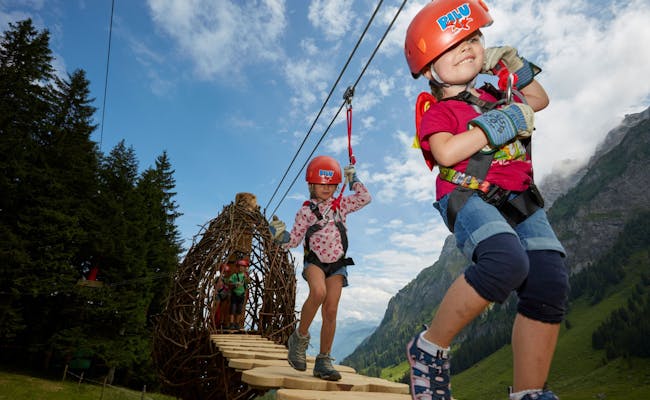 Pilatus PILU Rope Park (Photo (c) PILATUS-BAHNEN AG)
Pilatus PILU Rope Park (Photo (c) PILATUS-BAHNEN AG) Pilatus PILU Playground (Photo (c) PILATUS-BAHNEN AG)
Pilatus PILU Playground (Photo (c) PILATUS-BAHNEN AG)The Klimsen Chapel is located at Klimsen Hochjoch at an elevation of 1,864 meters. Consecrated in 1861, it originally belonged to the Klimsenjoch Hotel. The hotel was demolished at the end of the 1960s. The chapel was last thoroughly renovated in 2003 and is now a listed building. A mountain service takes place here (regardless of the weather) on the third Sunday in August. The Klimsen Chapel is situated between Oberhaupt and Klimsenhorn. It can be reached in about 3.5 hours via a mountain hike starting from Fräkmüntegg (cable car station). Along the way, some sections are secured with ropes. It can be slippery when wet. This hike requires absolute sure-footedness and experience in mountain hiking.
From Lucerne, you can plan an outing as a Pilatus round trip: take the cable cars up the mountain, descend via the cogwheel train, and return by boat to Lucerne. This tour is called the Golden Round Trip and can also be done in reverse. When combined with the train instead of the boat, it’s referred to as the Silver Round Trip. However, in winter, both the cogwheel train and the boat service take a break.
Offer from Swiss Activities:
The cable cars of Pilatus include a cogwheel train, a panoramic gondola, and an aerial cable car called the Dragon Ride.
The cogwheel train is the steepest in the world, traveling at a 48-degree incline from Alpnachstad up to Pilatus. It covers 4.6 km in about 30 minutes, climbing 1,635 meters in elevation. Passengers can request to disembark at the intermediate station Amsigen, but access is only allowed if there is actually space available. The cogwheel train operates from May to November.
A panoramic gondola runs from Kriens to the Fräkmüntegg station, crossing over the area above Krienseregg. Kriens is about 500 meters above sea level, Krienseregg is at 1,026 meters, and Fräkmüntegg is at 1,416 meters. First opened in 1954, it was modernized in 1996. The gondola covers an elevation of 899 meters and takes about 30 minutes. Each of the 132 cabins can hold four people.
In Fräkmüntegg, the Dragon Ride aerial cable car connects and goes up to Pilatus Kulm. It has two cabins, each accommodating 55 people (+1), that travel alternately up and down. Originally, an aerial cable car was put into service on the route in 1956 and was revamped in 1983. A thorough modernization took place in 2015. The journey takes just under four minutes, covering 646 meters in elevation. It usually operates every 15 minutes. Both aerial cable cars run all year round, except for maintenance periods, which typically occur from late October to early November.
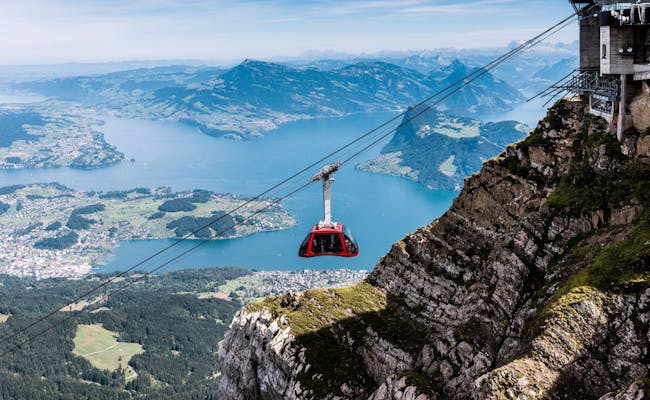 Pilatus DragonRide Summer Lake Lucerne (Photo (c) PILATUS-BAHNEN AG)
Pilatus DragonRide Summer Lake Lucerne (Photo (c) PILATUS-BAHNEN AG)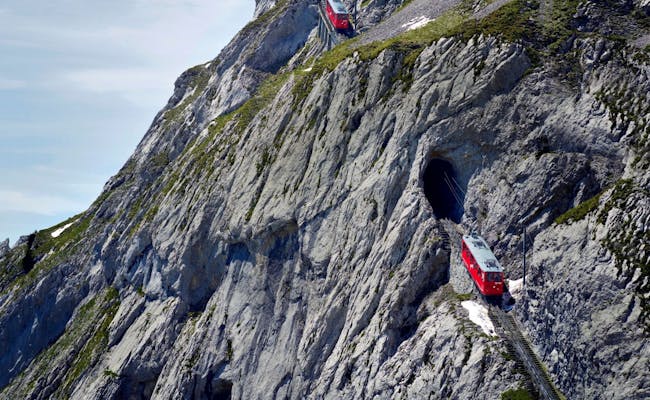 Pilatus Cogwheel Railway at Esel Wall (Photo (c) PILATUS-BAHNEN AG)
Pilatus Cogwheel Railway at Esel Wall (Photo (c) PILATUS-BAHNEN AG)In summer, people from Lucerne love making their way up to their local mountain, Pilatus. But visitors and tourists from further afield also enjoy the mountain range. Winter activities on Pilatus primarily take place from Fräkmüntegg down to Krienseregg. It’s a fantastic spot for tobogganing and snowshoe hiking.
The following activities are particularly popular on Pilatus:
A helicopter tour from Lucerne is one of the truly extraordinary experiences on Pilatus.
Fräkmüntegg is home to a large climbing paradise for kids, teenagers, and the young at heart.
At the mountain station of the cable car, there are various outdoor facilities for kids. Safety is always and everywhere well taken care of. The kids can climb, balance, and zip through the forest on rope slides (Tyrolienne).
The Rope Park includes:
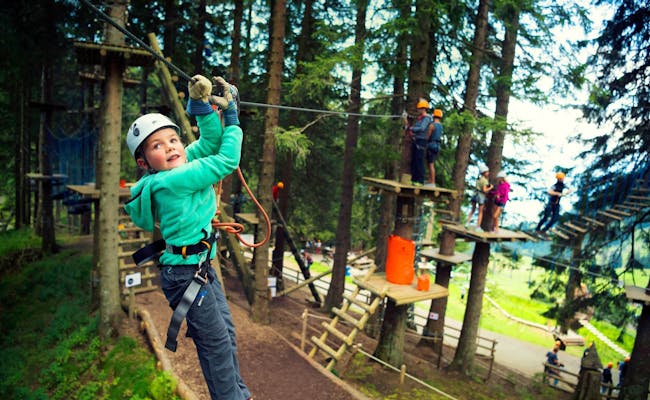 Pilatus Rope Park Fräkmüntegg (Photo: (c) PILATUS-BAHNEN AG)
Pilatus Rope Park Fräkmüntegg (Photo: (c) PILATUS-BAHNEN AG)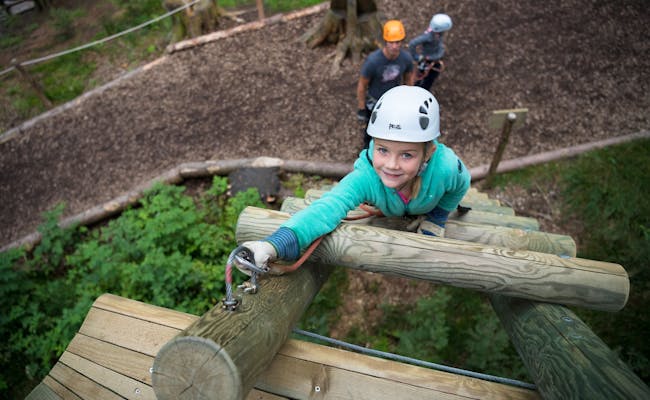 Pilatus Rope Park Fräkmüntegg (Photo: (c) PILATUS-BAHNEN AG)
Pilatus Rope Park Fräkmüntegg (Photo: (c) PILATUS-BAHNEN AG)Other facilities at Fräkmüntegg:
Mountain hikes on Mount Pilatus, with Mount Pilatus Kulm as the starting point and high-altitude hikes as circular walks: Mount Pilatus has many different trails to offer. There is always a wide view of Lake Lucerne and its surroundings.
Easy and more difficult mountain hikes lead around Mount Pilatus. Some paths are good to walk with the whole family. These include the circular hikes, which are possible as beautiful high-altitude hikes on Mount Pilatus.
The mountain massif has many peaks and the mountain chain stretches from west to east over these peaks:
From Pilatus Kulm via Fräkmünt to Ämsigen leads a path of just under ten kilometers, which with 361 meters of ascent as a rather easy path is also possible with Kinderb. However, 1000 vertical meters of descent have to be mastered. From the summit, this trail zigzags steeply down to Chilchsteine at the foot of the Matthorn. The rack railroad stops at Ämsigen station and takes hikers back to the valley station in Alpnachstad. To get to the starting point of the hike, the rack railroad is also used for convenience.
Among the more difficult hikes are the ascents to Mount Pilatus from Alpnachstad, Kriens, Hergiswil or Obernau or via the Heitertannliweg. The high-altitude route Langis-Pilatus with just under 1,400 meters of altitude gain also counts among them. This tour starts at the mountain hotel Langis and first leads eastwards over a small hill to the mountain restaurant Schwendi Kaltbad. A beautiful moor landscape is hiked through. Via the Schlierengrad you finally reach the Pilatus. The eight-hour tour is about 22 kilometers long and is one of the most beautiful hiking trails on Mount Pilatus.
From Kriens or Alpnachstad, the ascent to Kulm takes about 4.5 hours
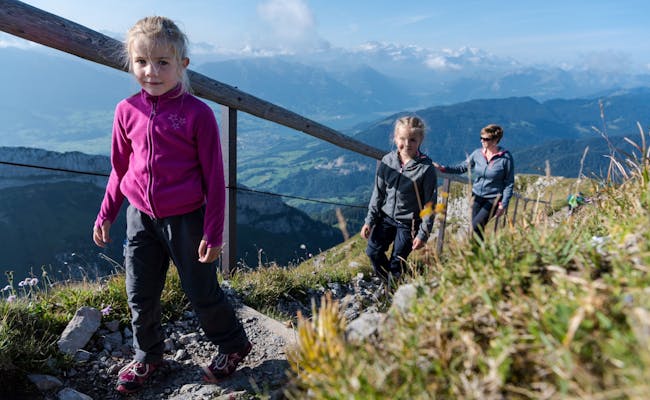 Pilatus Hiking (Photo: (c) PILATUS-BAHNEN AG)
Pilatus Hiking (Photo: (c) PILATUS-BAHNEN AG)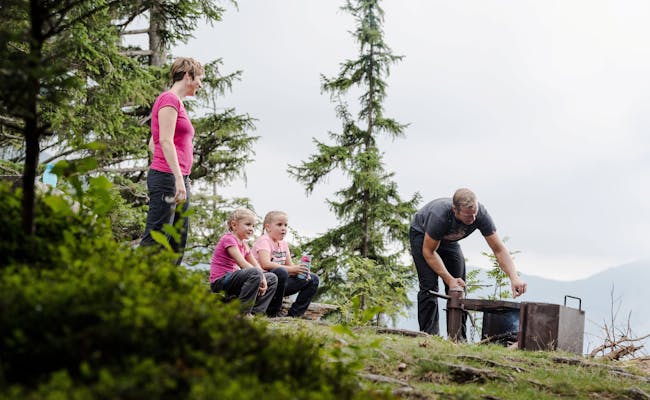 Pilatus Bräteln (Photo: (c) PILATUS-BAHNEN AG)
Pilatus Bräteln (Photo: (c) PILATUS-BAHNEN AG)Riding a mountain bike over Mount Pilatus is very popular. By the way, the Pilatus cable cars do not take bikes and mountain bikes. So you have to drive up yourself to enjoy the bike tour at the top, too. One popular tour starts and ends at the train station in Alpnach. It is 23 kilometers long and takes about 4.5 hours. Just under 1,500 meters in altitude have to be climbed. Along the way, you will pass Lütoldsmatt and Fräkmünt to Pilatus and return via Chli Turren and Niderstad. The mountain paths are sometimes very steep and the last twenty minutes before the summit you even have to push. The descent then also requires strength and skill. Partly the path leads over scree, rocks or roots.
At about 37 km, the route from Kriens via Hergiswald, Lifele, Schwarzenberg, Schachen, Malters, Blatten and Obernau back to Kriens is even longer. This tour is run as Pilatus - DominoTour No. 8. It leads through the wooded Pilatus north foot. Once the ascent altitude is reached, the ride becomes very pleasant. There are not much more than 700 meters of altitude to climb.
Special biker routes have been set up and signaled in the Kriens-Hochwald area.
Pilatus is a challenging flying area for paragliders. A good weather check is absolutely essential before each flight. You can get information from the information board at the valley station of the Pilatus cable cars in Kriens and the Paragliding Club Lucerne.
The wildlife protection areas and controlled airspaces around Pilatus must also be observed. Several civil and military airfields are located nearby. Therefore, you can only fly with a paraglider with permission from the tower.
Tandem flights at Pilatus generally take off below the Pilatus Kulm Hotel. The flying area is associated with high altitudes and active thermals over Lucerne. The special experience comes from the fantastic panoramic view of the lakes and mountains.
Offers from Swiss Activities:
 Pilatus Hotel Sunrise (Photo: (c) PILATUS-BAHNEN AG)
Pilatus Hotel Sunrise (Photo: (c) PILATUS-BAHNEN AG)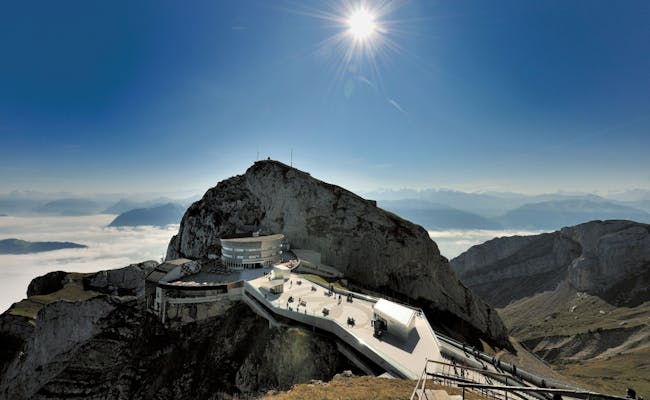 Pilatus Oberhaupt Hotel Bellevue (Photo: (c) PILATUS-BAHNEN AG)
Pilatus Oberhaupt Hotel Bellevue (Photo: (c) PILATUS-BAHNEN AG)Various downhill runs are available for sledging. The ride on the Panorama gondola lift can be purchased as a partial route. However, it is already included in the Pilatus Snow & Fun day ticket.
An easy sledging tour leads over just under five kilometers from Fräkmüntegg to Krienseregg. It has the number 3 and is classified as a blue run.
Also between Fräkmüntegg and Krienseregg, the number 2 toboggan run, which is classified as medium to difficult (red run), leads over three kilometers.
On Krienseregg snowshoes can be rented. Between Krienseregg and Fräkmüntegg there are three marked snowshoe trails. On the way, the beautiful view of Lucerne, Lake Lucerne and the northern foothills of the Alps can be enjoyed with the whole family.
The Snowshoe Trail LU 13 from Fräkmüntegg via Bonere, Mülimäs and Gibelegg to Krienseregg leads downhill. On the way, the route of the gondola lift is crossed. For refreshments, there is the Berghaus Ricketschwändi at about 1,000 meters above sea level. On a length of almost four kilometers, more than four hundred meters of altitude are descended.
The Snowshoe Trail LU 14 leads from Krienseregg via Ricketschwändi and Dorschnei back to Krienseregg. You can stop for a bite to eat along the way at the Bergbeizli Dorschnei. On the five-kilometer-long route, two hundred meters in altitude are overcome in ascent and descent.
The Snowshoe Trail LU 15 starts in Fräkmüntegg and leads via Bonern and Rehlöcher back to Fräkmüntegg. Back at the starting point, you can stop at the Restaurant Fräkmüntegg. This route is about three kilometers long and overcomes about 150 meters of altitude up and down.
In Krienseregg there is a rental station for various snow sports equipment such as toboggans, Ghosky sleds and snowshoes.
Only touring skiers are allowed to transport touring skis or splitboards - exclusively in the equipment trolleys, using ski bags provided for this purpose - from Kriens to Fräkmüntegg. Transport in the gondolas is prohibited. Freeride skiing is prohibited, as alpine hazards such as in particular weather change, avalanches, falling rocks and steep terrain do not allow safe skiing. The toboggan runs may also not be used by skiers.
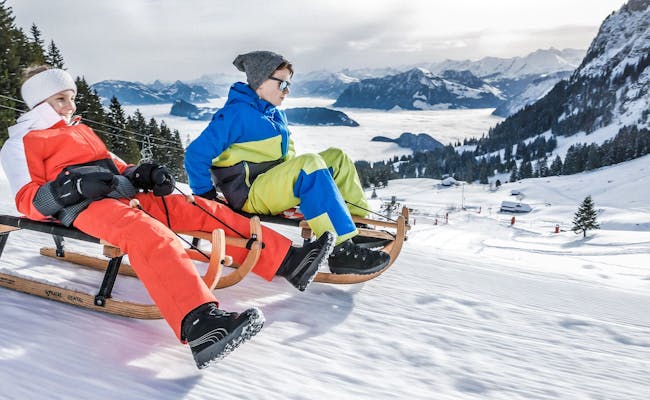 Pilatus Sledding (Photo: (c) PILATUS-BAHNEN AG)
Pilatus Sledding (Photo: (c) PILATUS-BAHNEN AG) Pilatus Snowshoeing (Photo: (c) PILATUS-BAHNEN AG)
Pilatus Snowshoeing (Photo: (c) PILATUS-BAHNEN AG)Special events are always taking place on Mount Pilatus. Be it a nature hike, a look at the stars or a culinary offer.
An ibex colony has been living on Mount Pilatus for around 50 years. Watching these skilled climbers in the wild is a very impressive experience. Experienced old gamekeepers from the region will tell you interesting facts about flora and fauna along the way. The safari can be booked online. The Ibex Safari takes place on fixed dates between June and October in any weather.
Includes:
The impressive evening atmosphere within a unique summit panorama and with a view of Lake Lucerne is experienced in the Bellevue Restaurant. This is accompanied by an exquisite buffet dinner. An overnight stay in one of the hotels on the Kulm is an ideal option.
Astronomy evenings are offered on fixed dates between the beginning of March and the beginning of November. Reservations are essential. Tickets can be purchased online.
Includes:
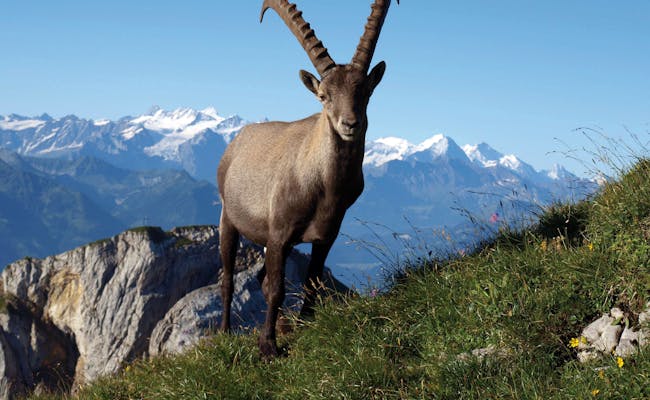 Pilatus Ibex (Photo: (c) PILATUS-BAHNEN AG)
Pilatus Ibex (Photo: (c) PILATUS-BAHNEN AG)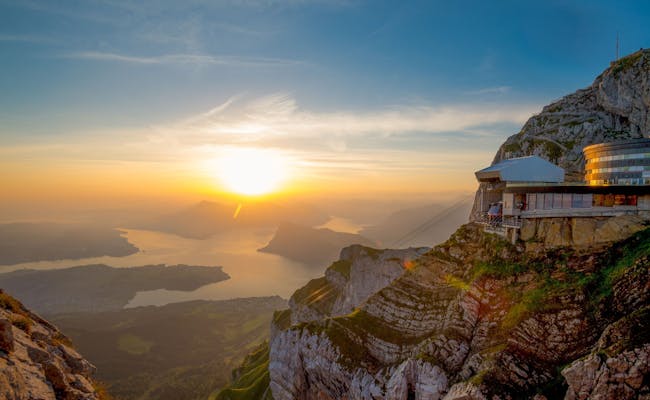 Pilatus Bellevue (Photo: (c) PILATUS-BAHNEN AG)
Pilatus Bellevue (Photo: (c) PILATUS-BAHNEN AG)There are two hotels and a total of six restaurants at Pilatus.
Both hotels at Pilatus Kulm are easily accessible.
This historical hotel was built in 1890 and completely renovated in 2010. It offers 27 Superior double rooms as well as three junior suites. All rooms feature breathtaking views of the Alpine panorama.
This hotel has 20 standard double rooms with comfortable furnishings and panoramic views of the bays and lake basins of Lake Lucerne, as well as the Alps.
At Pilatus, you'll find several restaurants catering to all tastes, from exquisite dishes to finger food and fries. They are mostly located near the cable car stations. The PILU Land children's playground features a family-friendly restaurant.
The restaurant is part of Hotel Pilatus Kulm. It consists of three halls and a sun terrace with 200 seats. The Queen Victoria Hall has 120 seats, the Cheminée Hall accommodates 60 guests, and the cozy Dohlenstübli with views of the Alps offers 30 seats. The exquisite dishes served here change seasonally. Groups of ten or more receive a special menu.
The Steinbock Bar offers refreshing drinks and delicious finger food.
The self-service restaurant at Kulm is affiliated with Hotel Bellevue. It has 120 indoor seats and 200 seats on the sun terrace. A mix of Swiss and international cuisine is offered.
On the panorama terrace at Kulm, there's a grill. Here, you can enjoy grilled food and crispy fries.
This mountain restaurant is self-service. It serves Swiss cuisine, featuring four different rösti variations. The spicy drachenrösti is the house specialty. Fresh salads are available from the abundant buffet. Homemade fruit cakes and desserts are perfect for both small and large sweet tooths. There are 120 seats available indoors and on the terrace. The restaurant can be reached via the Panorama gondola from Kriens in about 30 minutes. From November to April, it offers a popular Sunday brunch, and reservations are required.
Drachenalp is directly accessible from Fräkmüntegg via the Dragon Glider. The large grilling area is designed for self-cooking. At the integrated kiosk, you can find meat and baked potatoes ready for grilling. Wine or ice cream can be purchased at the kiosk.
This restaurant is particularly family-friendly and offers pizza and pasta. The PILU-Land playground is nearby. This self-service restaurant is located right next to the middle station of the panorama gondola and is perfect for a family outing.
Next to the valley station of the Pilatus cogwheel railway is the self-service restaurant with a garden terrace. Here, you can buy snacks like homemade paninis or Kernser Hörnli. Additionally, delicious veal paillard and other regional main dishes are available for big appetites. The restaurant by the lake also offers very popular zander bites. The sun terrace has seating for 100 guests.
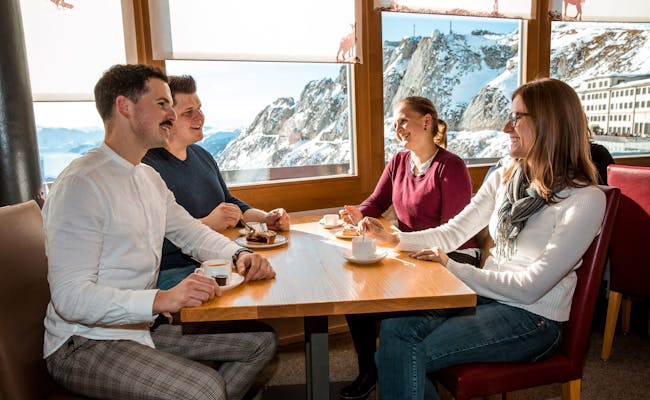 Pilatus Restaurant Bellevue (Photo: (c) PILATUS-BAHNEN AG)
Pilatus Restaurant Bellevue (Photo: (c) PILATUS-BAHNEN AG)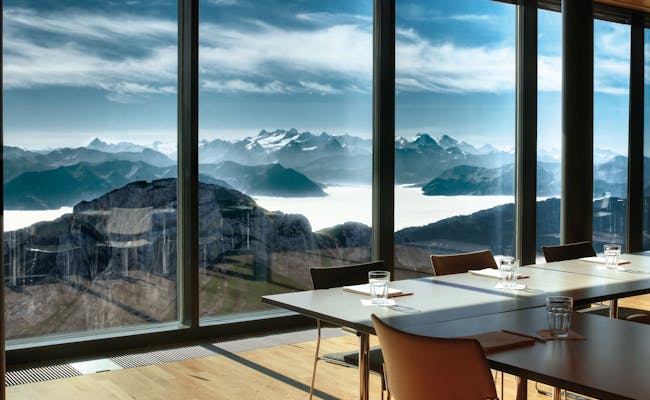 Pilatus Business Center (Photo: (c) PILATUS-BAHNEN AG)
Pilatus Business Center (Photo: (c) PILATUS-BAHNEN AG)Mount Pilatus is very centrally located in Switzerland and is easily accessible from all directions. The valley stations of the mountain railroads are in Alpnachstad and Kriens/Lucerne. Both can be reached directly via freeways, by train, bus or boat.
The train station, boat landing stage and parking lot are right next to the Pilatusbahn valley station.
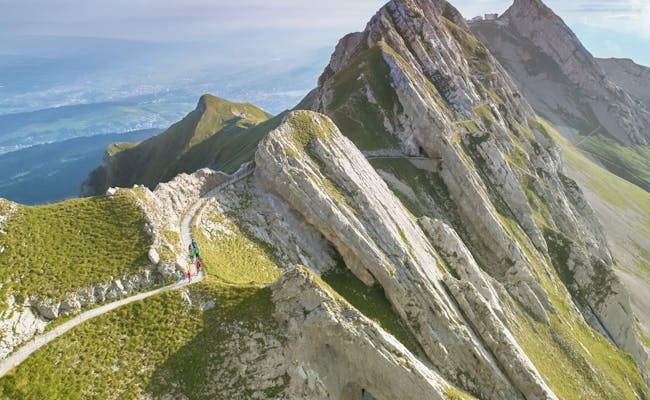 Pilatus Hiking (Photo: (c) PILATUS-BAHNEN AG)
Pilatus Hiking (Photo: (c) PILATUS-BAHNEN AG)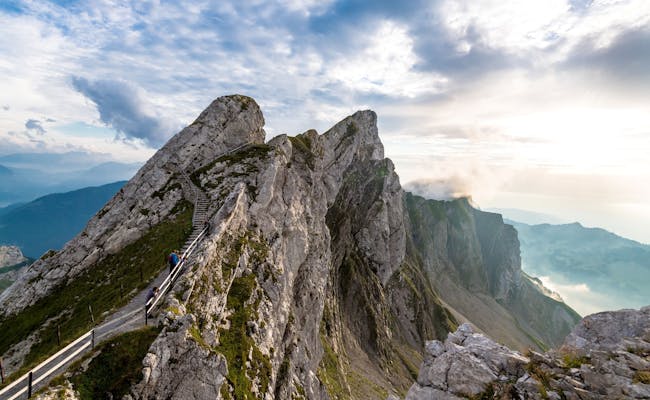 Pilatus Hiking (Photo: (c) PILATUS-BAHNEN AG)
Pilatus Hiking (Photo: (c) PILATUS-BAHNEN AG)